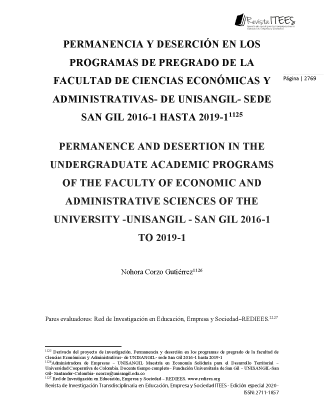CXLIV. PERMANENCE AND DESERTION IN THE UNDERGRADUATE ACADEMIC PROGRAMS OF THE FACULTY OF ECONOMIC AND ADMINISTRATIVE SCIENCES OF THE UNIVERSITY -UNISANGIL - SAN GIL 2016-1 TO 2019-1
##plugins.themes.bootstrap3.article.main##
Abstract
The present work analyzes the permanence and student desertion in the undergraduate
programs of the Faculty of Economic and Administrative Sciences- UNISANGIL- Sede San
Gil. The specific objectives were: Recognize the existence of periodic characterization
records of the students, who carry out academic programs, considering vulnerability
variables. 2. Determine student dropout, the factors that affect it and economic impact on
academic programs. 3. Identify strategies for permanence in quality conditions at the
institutional level and academic programs and their relationship with student dropout and
retention of according to the teaching methodology of the programs. The research
methodology was of a descriptive quantitative approach and of a transversal nature.
Some of the main results obtained are that 56% of the dropout students are women and 44%
men, 50% of the students drop out in the first semester and 38% drop out of their studies in
the 3rd semester, 64% of students do not continue with their studies due to financial
problems, 80% of dropout students belong to stratum 2, which is more difficult to continue
with University studies.
Download Statistics
##plugins.themes.bootstrap3.article.details##
higher education, retention, permanence, desertion.
de la deserción universitaria en Colombia. Más allá de las mediciones. Cuadernos
Latinoamericanos de Administración, IX (16), 55-66. Recuperado de:
http://www.redalyc.org/articulo.oa?id=409633954005
Durán Aponte E y Pujol L. (2013). Retención y deserción de estudiantes en el nivel
universitario
Flórez, E., Carrascal, J. (2016). Estudio de la deserción estudiantil de la Licenciatura en
Ciencias Naturales y Educación Ambiental de la Universidad de Córdoba-Colombia2011 – 2015. Revista científica, 4(27), 340-350.
DOI:https://doi.org/10.14483/udistrital.jour.RC.2016.27.a4
Ministerio de Educación Nacional- MEN (2015).- . Estrategias para la permanencia en
Educación Superior: Experiencias significativas Obtenido de
https://www.mineducacion.gov.co/1759/articles-356276_recurso.pdf.
Organización de Estados Iberoamericanos para la Educación, la Ciencia y la Cultura OEI.
(2010). Metas Educativas 2021: la educación que queremos para la generación de los
bicentenarios. Recuperado de: file:///C:/Users/Usuario/Downloads/metas2021.pdf
Sánchez Amaya, G., Navarro Salcedo, W., & García Valencia, A. (2009). Factores de
deserción estudiantil en la Universidad Surcolombia. Paideia Surcolombiana, 1 (14),
pag 97-103. DOI: http://dx.doi.org/10.25054/01240307.1083.
Zárate, R., Mantilla, E. (2014). La deserción estudiantil UIS, una mirada desde la
responsabilidad social universitaria. Zona Próxima, (21), 121-134. Recuperado de:
http://www.redalyc.org/articulo.oa?id=85332835010





